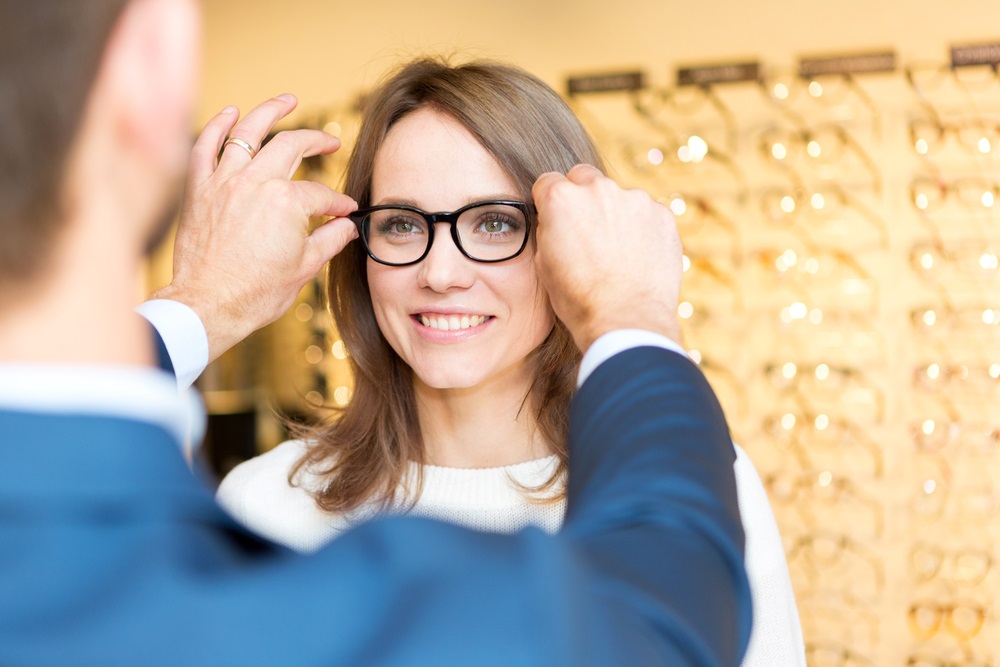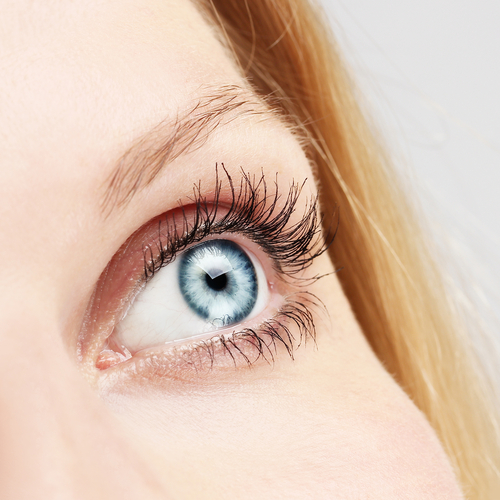Helpful Tips to Protect Your Eyes from Digital Eye Strain

Growing up in today’s day and age it’s not if you will use technology throughout the day – it’s about how long your day will be consumed behind a screen. Whether you’re sitting at work behind a computer for 8 hours or lounging on the couch scrolling through your newsfeed you could be experiencing the side effects of Digital Eye Strain.
Digital Eye strain is also known as computer vision syndrome and is the physical discomfort you may experience from looking at a screen for too long throughout your day. As technology has become increasingly popular over the years there has been an increase in the number of people who experience the side effects of this condition. Luckily for you, there are many steps you can take to help relieve and reduce your symptoms of digital eye strain.
Some symptoms of digital eye strain that you may experience include:
- Dry eyes
- Squinting
- Headache
- Neck, shoulder, or back stiffness
- Double or blurred vision
- Increased sensitivity to light
- Difficulty concentrating
- Feeling like you cannot keep your eyes open
Tip 1: The first suggestion we have to give you in an effort to reduce your symptoms is to try and follow the 20-20-20 rule. The 20-20-20 rule states that if you are working behind a screen for an extended amount of time it is important to take a break after 20 minutes for 20 seconds to look at something that is at least 20 feet away from you. In doing this you are giving your eyes a chance to completely relax and to focus on something other than your device.
Tip 2: Blink. This is a very important step to follow when looking at a screen for a long time because it’s something people often forget to do. As natural and easy as it is to blink a lot of times when using a computer, smartphone, or tablet our blinks are incomplete. Incomplete blinks can result in a number of the symptoms listed above. In order to reduce dryness in your eyes, it is important to keep blinking and keep your eyes hydrated.
Tip 3: Adjust your work area. It is important to make sure that you are reducing the amount of overhead lighting in your work area which will decrease the glare that reflects off your screen. This is a big advantage for your eyes. Another crucial step to take is to make sure that you are not sitting too close to your screen which can cause additional eye damage. To reduce eye strain make sure you are positioned slightly above your screen when doing this you cut down on the amount of stress that you are putting on your eyes throughout the day.
Tip 4: Schedule an eye exam. It is important to regularly get your eyes examined. At your next appointment talk with us about how much digital use you are having so, we can discuss viable solutions and alternative steps you can take to reduce your symptoms of digital eye strain.

You go to any appointment and you hear an abundance of medical terminology that you might not understand – we’ve been there too. When you are at your eye appointment you might hear the terms nearsightedness and farsightedness. You might even be dealing with one of these conditions. But what do they both mean?
First, let’s start off with nearsightedness. Nearsightedness, also known as myopia is a condition where you have trouble clearly seeing objects that are far away from you but have no issues seeing objects up close. For example, if you are dealing with myopia you generally won’t have any problems when you are using a computer or reading. People who suffer from myopia may have trouble reading road signs while driving, a white board at school, or being able to make out objects that are at a distance away from you. In most cases, people generally start experiencing blurry vision caused by nearsightedness at an early age. It was reported that 40% of the world’s population suffers from this condition and that percent will only continue to grow over the years.
Next up is farsightedness. Farsightedness also known as hyperopia is the condition where people have no problem seeing things at a distance but struggle when they are trying to see things close up. Someone with this condition may have trouble reading or using a computer but will have no problem seeing objects that are further away from them. Farsightedness tends to run in families and is commonly present at birth.
Luckily for people dealing with nearsightedness and farsightedness, there are many options you have to enhance your vision. Some options you have are getting prescription eyeglasses or contacts in order to see clearly again!

It is well known that smoking is the leading cause of serious health conditions that affect your lungs, heart, and much more. What most people don’t know is how smoking negatively impacts your eyes and puts you at an increased risk of developing cataracts, diabetic retinopathy, age-related macular degeneration, and dry eye syndrome. Read more about how smoking increases the risks of developing these conditions.
Cataracts is an eye disease that causes your natural lens to cloud. Studies have shown that smoking doubles your chances of developing cataracts. These chances continue to rise as you smoke more and more. Right now Cataracts is the leading cause of blindness in the world and smoking only continues to put you at a higher risk of developing a Cataract.
Diabetic Retinopathy is a condition that occurs when there is damage to the blood vessels in the tissue at the retina. This disease occurs in people who suffer from diabetes and is the leading cause of vision loss in people who are dealing with diabetes. By smoking, you’re twice as likely to develop diabetes which puts you at risk for Diabetic Retinopathy, as well as numerous other diabetes complications.
Age-Related Macular Degeneration (AMD) is when your macula, the small center of the retina starts to deteriorate. When this part of your eye starts to deteriorate you start to lose your sharp, central vision making it difficult to do everyday tasks. Smoking puts you at three times the risk of developing Age-Related Macular Degeneration.
Dry Eye Syndrome occurs when your eyes aren’t producing enough tears to lubricate the eye. Smoking cigarettes is known to cause dry eye because the smoke is a well-known eye irritant. When your eyes are exposed to tobacco smoke it increases your symptoms of Dry Eye which include eye redness and itchiness.
It is important to know the risks that are associated with smoking when it comes to your total health, including your eyes. By quitting smoking you can help reduce your risks of developing one of these eye conditions!

We fuel our body with foods for our overall health but have you ever put in any thought about which foods have the best impact on our eye health? We are here to help! Check out which food groups will help keep you and your eyes healthy!
Fish, Nuts & Seeds: The first suggestion we have for you is to consume foods that contain omega 3 fatty acids! It is important to get a general intake of omega 3 fatty acid because of the overall health benefits you get. These benefits include maintaining cardiovascular health by lowering blood pressure, cholesterol levels, and triglyceride levels. Not only are omega 3 fatty acids good for the rest of your body they are also great for your eyes. It is proven that they can help with dry eyes, macular degeneration, and cataracts. Some foods that you can eat to ensure you are getting this nutrient are Fish such as salmon, tuna, mackerel as well as nuts and seeds like walnuts, flaxseed, and chia seeds.
Whole Grains: Keeping your diet rich in whole grains can be beneficial to your overall health as well as your eye health! By substituting white flour products with whole grain options such as brown rice, whole wheat pasta, quinoa you can help reduce your risk of age-related macular degeneration.
Leafy Greens: It is vital to your eyesight that you have a diet that is rich in Lutein and Zeaxanthin. These nutrients help keep your eyes on their A game. Some foods that would fall under this category and give you the nutrients you need would be kale, spinach, collards, as well as a number of other greens.
Citrus Fruits and Veggies: Keep your diet rich by fueling your body with an assortment of citrus fruits and berries! This gives your body the Vitamin A and C that it needs and helps keep your eyes in the best shape. Vitamin A and C have proven to be very beneficial for your eye health and by keeping your diet full of them your eyes will thank you! Some examples of common foods you could eat to get your fix of Vitamin A and C are oranges, grapefruit, apricots, plums, carrots, peppers, and many others.

Many of us use computers for many, if not all, of our work-related tasks. Constantly staring at a computer screen can cause eyestrain, which has become a major problem for many. Studies show that eyestrain occurs in 50 to 90 percent of those who use a computer for work.
Eyestrain can cause sore, itchy, tired eyes and can also result in headaches, sore neck and back, difficulty focusing, and sensitivity to light. While almost anyone can suffer from eyestrain, those who use a computer for several hours a day are at a higher risk of developing symptoms.
Ergonomics can help reduce the risk of eyestrain and ease many of its inconvenient and uncomfortable symptoms. Ergonomics is the study of people’s efficiency in their working environment. The goal of ergonomics is to create workspaces that properly fit people to help optimize their performance and reduce their risk of injury. While eyestrain is temporary and generally not serious, this type of visual impairment can often impair workers’ performance.
Here are a few easy ways to help reduce eyestrain using proper ergonomics.
- Be sure to sit up straight so that your head is in line with your torso and keep your head lifted upright, not bent down or tilted back.
- Sit with your shoulders square to your screen so you’re facing it directly without having to turn your head or twist your torso.
- Position your computer screen so that any windows in your office or work area are to the side rather than in front of or behind the screen. This will help minimize bright light that may cause eyestrain. Control natural light with shades, blinds, curtains, or window tinting and adjust the position of your screen to help reduce reflection from overhead lighting. You can also use an anti-glare screen filter.
- Make sure your computer screen is approximately 18 to 30 inches away from your eyes. Your screen should be close enough that you can read text easily without leaning forward. Looking at a screen that is too far away can cause you to strain your eyes to see small text while a screen that’s too close can make it difficult for your eyes to properly focus.
- Whenever you’re using printed documents in conjunction with your computer screen, use a document holder to keep those printed sheets in place. Place the document holder at the same height and distance as your computer screen to make it easier for your eyes to move back and forth from screen to print document.
- Be sure to follow the 20-20-20 Rule. After every 20 minutes of computer work, focus on an object 20 feet away for 20 seconds. Make sure to blink during this time as well. Take a more substantial break of 15 minutes or more for every two hours of moderate computer use or every hour for intense computer work.
- Schedule a comprehensive eye exam with your eye doctor. Almost 71% of people who report symptoms of computer eyestrain wear eyeglasses or contacts so it’s important to make sure that your prescription is correct and up to date. Tell your doctor about your workstation setup and the number of hours you spend each day on electronic devices and if you are experiencing symptoms of eyestrain so they can make the best treatment recommendations possible.
April is Women’s Eye Health and Safety Month. Did you know that more women suffer from visual impairments than men? Two thirds of blindness occurs in women, fortunately 75% of visual impairment is preventable and/or treatable. One reason why women are affected by more eye health issues than men is because they tend to live longer. According to the National Eye Institute, women are also affected by hormonal factors. Some other risk factors in women are caused by smoking, poor nutrition and obesity. Here are some tips to ensure the health of your eyes and vision.

Get your eyes examined
It’s important to be proactive, so start by scheduling regular eye exams as part of your health routine. Prevent Blindness America recommends that everyone have a comprehensive eye exam by age 40, if not earlier, and to receive follow up care as recommended by your eye doctor.
Eat healthy
A healthy diet makes for healthier eyes. It is recommended that women eat a diet rich in vitamin C, vitamin E, beta carotene, lutein, zeaxanthin, zinc and omega-3 fatty acids. This includes eating two weekly servings of fish, such as salmon and sardines. Dark leafy greens and broccoli are also excellent foods to incorporate into your diet.
Stay active
Regular exercise is known to reduce the risk of eye disease. While you’re out being active, make sure to wear proper sun protection, like hats and sunglasses. These are some straightforward, easy and effective measures that will go a long way in protecting your vision.
Learn more about dry eye syndrome
Dry eye syndrome affects an estimated 3.2 million women in America and is classified as itching, burning and irritation in the eyes due to a lack of tears to lubricate and nourish the eyes. Without proper moisture, dry eye can result in damage to the frontal surface of the eye and ultimately lead to impaired vision. Your best defense is to discuss dry eye with your doctor and stay informed of what your treatment options may be.
We encourage women to take care of their eyes not only during Women’s Eye Health and Safety Month, but all year round.
Welcome to WordPress. This is your first post. Edit or delete it, then start writing!

We’ve all been there before, you fall asleep on your couch watching TV or get home from a long day at work and wake up with your contacts still in. We know we shouldn’t sleep in our contacts but mistakes are inevitable. But why is it so bad for us to wear our contacts overnight?
Falling asleep with your contacts in causes an oxygen deprivation in your eyes. During the day, it is possible for air to get into your eyes but when you’re asleep your cornea relies on the hydration from your gelatinous fluid and tears to get its nourishment. Your eyes become deprived of oxygen because your contacts are a blockade between your corneas and your eyelids. Bacteria and other potentially dangerous things can build up in your eye and end up causing severe damage.
If you accidentally fall asleep with your contacts still in it is important to not take them out directly after waking up. Taking them out immediately could result in exposure to more bacteria. As soon as you wake up oxygen will begin to reach the surface of your eyes which will result in the swelling of the cornea to go down. It’s recommended to use eye drops to re-wet your eyes and help with the process of removing your contact lenses. After you have followed these steps you can remove the contact and give your eyes time to rest.
Some symptoms that you may experience after sleeping in your contacts include but are not limited to:
- Eye Pain
- Redness
- Sensitivity to light
As a precaution, it is recommended that you remove your contacts at least an hour before bed. This will give your eyes additional recovery time before bed and will help you not to forget to remove them. To make this easier it is also recommended to have an updated pair of glasses you can use during this resting period.

Cataracts are the leading cause of blindness in the world: Currently, cataracts affect more than 22 million people in the United States that are above the age of 40. Worldwide there are more cataract cases than macular degeneration, glaucoma, and diabetic retinopathy combined according to Prevent Blindness America (BPA).
There are several symptoms of cataracts: When you first start experiencing the symptoms of cataracts they may only be affecting a small portion of your lens causing you to be unaware of the vision loss that you are incurring. As the cataract increases in size, this may result in side effects such as:
- Blurry, clouded vision
- Difficulty with night vision
- Sensitivity to light
- Seeing bright colors as faded or yellow
- Seeing double of things
If you are experiencing any of the symptoms listed above it is important to take the first step and schedule an appointment for an eye exam.
Surgery is the only proven treatment for cataract: As of right now, the only way to treat a cataract is by surgery. During this procedure, your natural, cloudy lens will be removed and replaced with an artificial, clear lens. The good news with this is that cataract surgery is an outpatient procedure. After surgery, you will be in a recovery area for around 30 minutes and then you will be released and able to return home the same day.
Cataracts surgery is extremely effective: Although surgery is currently the only option to treat cataracts, it was reported by the American Society of Cataract and Refractive Surgery (ASCRS) that the overall success rate of this procedure is 98 percent with over 3 million people undergoing this procedure every year.
Everyone knows sunglasses are cool, but what you may not know is that they can protect your vision. You might be saying “I thought sunglasses were just an accessory?” Well, they are an accessory! but they are also a utility. Sunglasses have been a fashion accessory for a very long time, but they can also block harmful rays from the sun.
Choosing the correct shades can help to not only protect your vision but also protect your face and reduce wrinkles as you age. The sun’s ultraviolet (UV) rays will cause permanent damage to your eye health with excessive exposure if left unprotected.
As mentioned previously, the suns UV rays can cause irreversible damage to your cornea, eyelids, lens and other areas of the eye. Certain studies even suggest that excessive amounts of UV radiation exposure to your eyes will increase risks of developing macular degeneration, pterygium and cataracts.
Not all sunglasses are the same however, when choosing the right pair of sunglasses, you need to make sure that the ones you are choosing block the necessary amount of UV rays to protect your vision. Contrary to popular belief, the darkness of the lens, does not have anything to do with the amount of UV rays that are blocked. Here are some things you should be on the lookout for when picking out a new pair of sunglasses:
- Labeled to block 99 – 100 percent of both UVA and UVB rays
- Screen 75 to 90 percent of visible light
Lenses are free from distortions and imperfections
